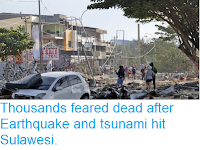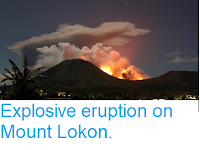The Volcanological Survey of Indonesia has reported a major new eruption on Mount Soputan, a highly active stratovolcano (cone-shaped volcano made up of layers of ash and lave) on northern Sulawesi. The agency began to detect seismic events (tremors) beneath the volcano at about 5.00 pm local time on Saturday 15 December 2018, which increased slowly overnight, with minor eruptive activity beginning at about 1.00 am, with lava fountains beginning at about 3.10 am. At about 5.40 am the volcano began to erupt far more energetically, producing an ash column that rose to about 8.8 km above sealevel.
An ash column over Mount Soputan, Sulaweisi, on the morning of Sunday 16 December 2018. Badan Nasional Penanggulangan Bencana.
Soputan is a small volcano in the Tondano
Caldera located near the eastern tip of the northern arm of Sulawesi.
The volcanoes of the northern arm of Sulawesi are located at the
southern end of the
Sangihe Volcanic arc, where an extension Molucca Sea Plate is being
subducted beneath an extension of the Eurasian Plate, sometimes called
the Sangihe Plate. As this happens part of the subducting plate is
melted by the heat of the Earth's interior, and rises up through the
overlying plate as liquid magma, forming volcanoes at the surface.
About 320 km to the east, the Molucca Plate is also being subducted
beneath an extension of the Philippine Plate, sometimes called the
Halmahera Plate, producing a second chain of volcanoes in the Halmahera
Islands. At some point in the future the Molucca Plate will vanish and
the two volcanic arcs will meet.
The subduction zones beneath Sulawesi and the surrounding islands. Hall & Spakman (2015).








